 Today was the second and last day of the 2012 BEST Competition – South Regional. Like the first day, it was frenetic, well-organized and a lot of fun. To get the main bit of business out of the way, the overall winner of the competition was the Cornerstone Christian Preparatory Academy from a suburb just outside Pittsburgh, Pennsylvania. Their overall score in several categories, Competition, Engineering Notebook, Display Booth, and some other categories, was the highest and so they were the overall winners. After the competition was over, I was able to track them down (not very hard – I just followed the sound of the loudest cheers) and spent several minutes talking with them and taking pictures – a great bunch of kids. They were trying very hard to talk me into visiting their school in the near future and talking about a Space Elevator – maybe we’ll be able to do it via Skype…
Today was the second and last day of the 2012 BEST Competition – South Regional. Like the first day, it was frenetic, well-organized and a lot of fun. To get the main bit of business out of the way, the overall winner of the competition was the Cornerstone Christian Preparatory Academy from a suburb just outside Pittsburgh, Pennsylvania. Their overall score in several categories, Competition, Engineering Notebook, Display Booth, and some other categories, was the highest and so they were the overall winners. After the competition was over, I was able to track them down (not very hard – I just followed the sound of the loudest cheers) and spent several minutes talking with them and taking pictures – a great bunch of kids. They were trying very hard to talk me into visiting their school in the near future and talking about a Space Elevator – maybe we’ll be able to do it via Skype…
Regarding the Climber competition itself, there were certainly no new Engineering principles at work here – they were robots, assembled from a Kit. I have posted a video of one of the competition runs at our new channel on YouTube: ISECdotORG. But the whole idea of the BEST competition, as I have written about earlier, is to encourage middle-school and high school level kids to get interested in techie stuff, science, engineering and technology. It certainly seems to have succeeded in doing that and I’m truly grateful that Mr. Brent Percival of Auburn University (where this competition was held) called me up (out of the blue) one day earlier this year and asked if ISEC would be interested in participating. We did spend some of our funds on sponsoring this competition and a few more of our dollars on hand-outs (posters, business cards, CLIMB Volume 1 and the ISEC report on Debris Mitigation) and I think it was very well worth it. I had people talking to me almost the entire time I was there about the Space Elevator.
Some anecdotes…
Just before noon, one of the competition organizers came up to me and told me that I and 9 other vendors / sponsors would be stationed at tables outside the arena. The idea was to give each of the kids participating in the competition a card with spaces on it for 8 different types of “stamps”. Each of us at a table would have a stamp and, as the kids came around and talked to us, we would stamp their card. If they were able to get all 8 of the stamps on their card, it would go into a drawing for a door prize. However, there were only 8 stamps for our 10 tables. At any one time, 2 of us would not have them. I had a steady stream of kids and their parents coming up to my table, wanting to get their card stamped and wanting to talk about the Space Elevator. Even when it wasn’t my turn to have a stamp, very few of the kids drifted away when they found that out – they really like the idea (and kids love posters and I had a lot of them to give away!). I had no idea this was going to happen – completely caught me by surprise. But it was a fun way to spend 2 hours, even if the back of my neck did get a little bit sunburned…
People sure treat you nice when they find out you’re a sponsor :). I was given an ‘all-access’ pass and was able to go anywhere I wanted and talk to anyone I wanted. I made a point of introducing myself to the event announcer. When I found out that his son was very much into robotics and the idea of a Space Elevator, I made sure to give him a copy of CLIMB, an ISEC Report, all 4 years of posters that we have and a couple of years of Conference proceedings to give to his son. I wasn’t looking for any favors, just trying to get the word out, but boy, did ISEC get top billing whenever they thanked their sponsors! Every other sponsor was just mentioned by name. When he mentioned ISEC, he raved about how this group was really working on the idea / project of building a space elevator. I would say, with a very high degree of confidence, that fewer than 10 people at the event knew about ISEC when the event started. But by the time we were finished, I had people coming up to me to talk to me, people would point me out when I walked by, everyone would say “Thank you for helping out this event”, etc., etc., etc… We truly did get some excellent publicity at this event.
A case in point was at the end of the competition and I tracked down the team from Cornerstone. Many of them knew who I was and what ISEC was about and they insisted that I join them for a group photo (which you can find on our Flickr account; ISECdoORG, along with other photos from the 2-day event). That was pretty cool…
 There was just a lot on fun, techy-nerdy stuff going on too. Each of the teams could submit a short video which was then displayed several times during the competition – and a winner was chosen at the end of the competition. The winning video was a play on Star Wars, with the punch line being “May the Centrifugal Force Be With You” – I love it! But my personal favorite (which took 2nd place) was about how Thor was banished from Asgard by his father. Naturally, he landed in a Science Class and, after he told the students his plight, they built him a Space Elevator so he could return home – very creative.
There was just a lot on fun, techy-nerdy stuff going on too. Each of the teams could submit a short video which was then displayed several times during the competition – and a winner was chosen at the end of the competition. The winning video was a play on Star Wars, with the punch line being “May the Centrifugal Force Be With You” – I love it! But my personal favorite (which took 2nd place) was about how Thor was banished from Asgard by his father. Naturally, he landed in a Science Class and, after he told the students his plight, they built him a Space Elevator so he could return home – very creative.
Each of teams had a mascot. There were robots (lots of different kinds), Sharks, Eagles, Tigers, etc., and, today, they held a “Dance-off” – again the top three each being awarded a prize. The audience really got into it (and so did the referees!). I took a video of the first round of competition, but didn’t post it as it did get a bit long. But the finals were short and fun and I’ve posted a video of that too. Sorry for the not-great quality. I tried to make my Canon point-and-shoot do double-duty (pictures and videos) and it just doesn’t do a great job on videos. But the final result was OK and I think you’ll enjoy watching it. And I’m also sorry that the song they danced to was “Gangnam Style” – it seems to be everywhere!
I think that’s it. I do want to sincerely thank the BEST organizers and the Auburn staff, especially Mr. Brent Percival who invited ISEC to participate, for all their kindnesses – they truly showed what Southern Hospitality was all about and they ran a great competition.
(The top photo thumbnail is of the representatives from Cornerstone, hoisting their trophy in triumph. Not great quality – taken on a camera phone so I could Tweet it right away. The bottom thumbnail is of my favorite poster at the event. Click on either to see a full-size picture and visit ISECdotORG on Flickr to see more photos from the Event).
 The World Space Elevator Competitions has a nice ring to it, don’t you think?
The World Space Elevator Competitions has a nice ring to it, don’t you think?
 Each year, the
Each year, the 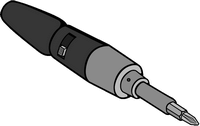 Sometimes the simplest ideas are the best. A couple of weeks ago, the Technion Institute in Israel held a Space Elevator competition (I’ve previously posted about this competition
Sometimes the simplest ideas are the best. A couple of weeks ago, the Technion Institute in Israel held a Space Elevator competition (I’ve previously posted about this competition  One year ago, the 2012 European Space Elevator Challenge (EUSPEC) was held in Germany, at TUM Campus Garching. A “highlights” video was created, which the EUSPEC team posted on
One year ago, the 2012 European Space Elevator Challenge (EUSPEC) was held in Germany, at TUM Campus Garching. A “highlights” video was created, which the EUSPEC team posted on  The
The 


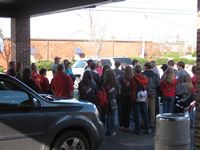
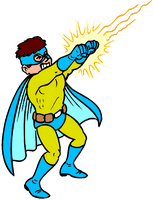 This August the KC Space Pirates will take the next step in the development of laser powered flight and in the art of wireless power beaming. We will attempt to keep a one pound robotic aircraft flying for 2 full days (48 hours), nearly 4 times the previous world record…The date of this attempt is set to coincide with the International Space Elevator Consortium’s (www.isec.org)
This August the KC Space Pirates will take the next step in the development of laser powered flight and in the art of wireless power beaming. We will attempt to keep a one pound robotic aircraft flying for 2 full days (48 hours), nearly 4 times the previous world record…The date of this attempt is set to coincide with the International Space Elevator Consortium’s (www.isec.org) This coming August, the
This coming August, the  The next space elevator competition here looks like it will be the first week of August 8/1-8/5. We will probably have a narrower/thicker tether 25mm x 1.2mm, and plan to get up past 1km this time. There is quite a bit of activity due to the recent report from Obayashi Consortium that they plan to build a space elevator by 2050.
The next space elevator competition here looks like it will be the first week of August 8/1-8/5. We will probably have a narrower/thicker tether 25mm x 1.2mm, and plan to get up past 1km this time. There is quite a bit of activity due to the recent report from Obayashi Consortium that they plan to build a space elevator by 2050. In early August of last year, the
In early August of last year, the 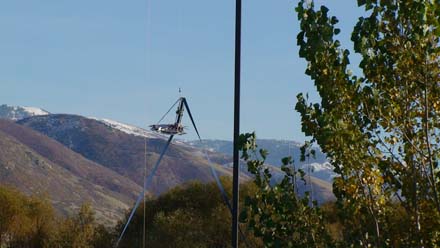
 Tomorrow, Friday, March 2nd, beginning at 1pm Eastern (10am Pacific),
Tomorrow, Friday, March 2nd, beginning at 1pm Eastern (10am Pacific), 
 Over at io9, they have a
Over at io9, they have a 




 On Friday, August 12th, the next installment of the
On Friday, August 12th, the next installment of the 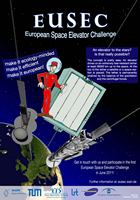

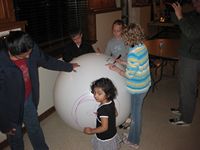
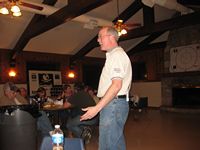
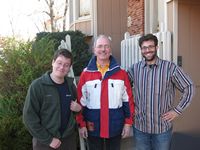
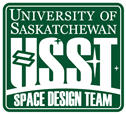 On the
On the 



 The Strong Tether challenge, part of the Space Elevator Games, is just three days away! It will be held at the upcoming
The Strong Tether challenge, part of the Space Elevator Games, is just three days away! It will be held at the upcoming  I’ve written about the
I’ve written about the  Just a case of the rich getting richer… Team LaserMotive, winners of a cool $900K in last year’s Climber / Power-Beaming portion of the
Just a case of the rich getting richer… Team LaserMotive, winners of a cool $900K in last year’s Climber / Power-Beaming portion of the  Many moons ago (Dec 28, 2007), Stan Taylor of the
Many moons ago (Dec 28, 2007), Stan Taylor of the 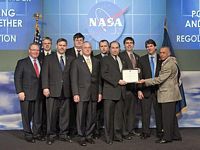 As I
As I  The
The 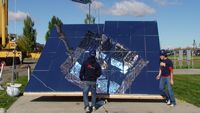
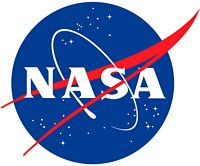 This past Thursday and Friday saw a meeting at NASA HQ in Washington, DC of all parties involved in the NASA Centennial Challenges. This is the NASA Press Release:
This past Thursday and Friday saw a meeting at NASA HQ in Washington, DC of all parties involved in the NASA Centennial Challenges. This is the NASA Press Release:
 Money quote (which occurred after their prize-winning runs on day 1) #1: ‘Waiting just a moment, Steve Beland requested clearance from Test Operations for the Team to begin breathing again. Test granted the request, but for “shallow breaths only”.’
Money quote (which occurred after their prize-winning runs on day 1) #1: ‘Waiting just a moment, Steve Beland requested clearance from Test Operations for the Team to begin breathing again. Test granted the request, but for “shallow breaths only”.’